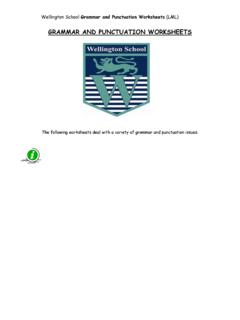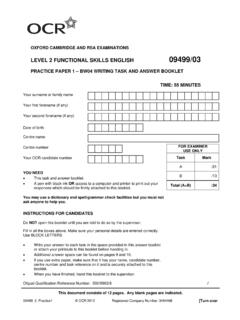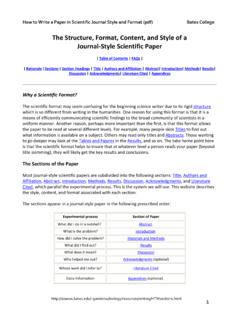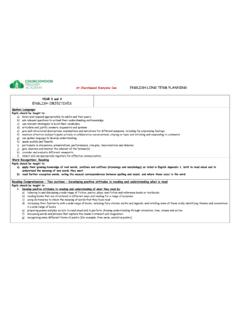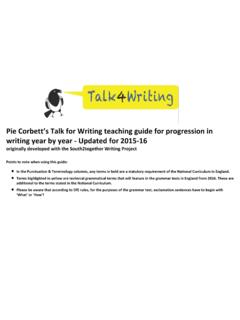Transcription of The NMEA 0183 Protocol - tronico.fi
1 The nmea 0183 ProtocolTable of is the nmea 0183 Standard?..page Sentence Identifiers and Sentence Proprietary material presented in this document has been compiled from various inofficial sources. It is neither acomplete nor error-free description of the nmea 0183 standard. In particular, it does not cover the newsentences and the high-speed interface defined in version Betke, May 2000. Revised August What is the nmea 0183 Standard?The National Marine Electronics Association (NMEA) is a non-profit association of manufacturers,distributors, dealers, educational institutions, and others interested in peripheral marine electronicsoccupations. The nmea 0183 standard defines an electrical interface and data Protocol forcommunications between marine 0183 is a voluntary industry standard, first released in March of 1983.
2 It has been updated fromtime to time; the latest release, currently (August 2001) Version , July 2001, is available from theNMEA office (Warning: the price for non-members is 250 US$).P O Box 3435 New Bern NC has also established a working group to develop a new standard for data communications amongshipboard electronic devices. The new standard, NMEA 2000, is a bi-directional, multi-transmitter,multi-receiver serial data network. It is multi-master and self-configuring, and there is no central NMEA began a beta testing period in January 2000 with eleven manufacturers. A release version ofNMEA 2000 is expected in Electrical InterfaceNMEA 0183 devices are designated as either talkers or listeners (with some devices being both),employing an asynchronous serial interface with the following parameters: Baud rate:4800 Number of data bits:8 (bit 7 is 0)Stop bits:1 (or more)Parity:noneHandshake:noneNMEA 0183 allows a single talker and several listeners on one circuit.
3 The recommended interconnectwiring is a shielded twisted pair, with the shield grounded only at the talker. The standard dos not specifythe use of a particular connector. Note: The new 0183-HS standard (HS = high speed) introduced inversion uses a 3-wire interface and a baud rate of 38400. This type of interface is not discussed is recommended that the talker output comply with EIA RS-422, a differential system with two signallines, "A" and "B". Differential drive signals have no reference to ground and are more immune to , a single-ended line at TTL level is accepted as well. The voltages on the A line correspond tothose on the TTL single wire, while the B voltages are inverted (when output A is at +5 V, output B is at0 V, and vice versa.)
4 This is the unipolar RS-422 operation. In bipolar mode 5 V are used).In either case, the recommended receive circuit uses an opto-isolator with suitable protection input should be isolated from the receiver's ground. In practice, the single wire, or the RS-422 "A"wire may be directly connected to a computer's RS-232 input. In fact even many of the latest products,like hand-held GPS receivers, do not have a RS-422 differential output, but just a single line with TTL or5 V CMOS compatible signal General Sentence FormatAll data is transmitted in the form of sentences . Only printable ASCII characters are allowed, plus CR(carriage return) and LF (line feed). Each sentence starts with a "$" sign and ends with <CR> <LF>.
5 Thereare three basic kinds of sentences : talker sentences , proprietary sentences and query sentences . The general format for a talker sentence is: $ttsss,d1,d2,..<CR> <LF> The first two letters following the $ are the talker identifier. The next three characters (sss) are thesentence identifier, followed by a number of data fields separated by commas, followed by an optionalchecksum, and terminated by carriage return/line feed. The data fields are uniquely defined for eachsentence type. An example talker sentence is:$HCHDM,238,M<CR> <LF> where "HC" specifies the talker as being a magnetic compass, the "HDM" specifies the magnetic headingmessage follows. The "238" is the heading value, and "M" designates the heading value as sentence may contain up to 80 characters plus "$" and CR/LF.
6 If data for a field is not available, thefield is omitted, but the delimiting commas are still sent, with no space between them. The checksumfield consists of a "*" and two hex digits representing the exclusive OR of all characters between, but notincluding, the "$" and "*". Proprietary sentences . The standard allows individual manufacturers to define proprietary sentenceformats. These sentences start with "$P", then a 3 letter manufacturer ID, followed by whatever data themanufacturer wishes, following the general format of the standard sentences . Some proprietarysentences, mainly from Garmin, Inc., are listed in chapter nmea 0183 Protocol2 Query sentences . A query sentence is a means for a listener to request a particular sentence from atalker.
7 The general format is:$ttllQ,sss,[CR][LF] The first two characters of the address field are the talker identifier of the requester and the next twocharacters are the talker identifier of the device being queried (listener). The fifth character is always a "Q"defining the message as a query. The next field (sss) contains the three letter mnemonic of the sentencebeing requested. An example query sentence is:$CCGPQ,GGA<CR> <LF>where the "CC" device (computer) is requesting from the "GP" device (a GPS unit) the "GGA" GPS will then transmit this sentence once per second until a different query is Talker IdentifiersAGAutopilot - GeneralAPAutopilot - MagneticCDCommunications Digital Selective Calling (DSC)CRCommunications Receiver / Beacon ReceiverCSCommunications SatelliteCTCommunications Radio-Telephone (MF/HF)CVCommunications Radio-Telephone (VHF)CXCommunications Scanning ReceiverDFDirection FinderECElectronic Chart Display & Information System (ECDIS)EPEmergency Position Indicating Beacon (EPIRB)EREngine Room Monitoring SystemsGPGlobal Positioning System (GPS)
8 HCHeading Magnetic CompassHEHeading North Seeking GyroHN Heading Non North Seeking GyroIIIntegrated InstrumentationINIntegrated NavigationLCLoran CPProprietary CodeRARADAR and/or ARPASDS ounder, DepthSNElectronic Positioning System, other/generalSSSounder, ScanningTITurn Rate IndicatorVDVelocity Sensor, Doppler, other/generalDMVelocity Sensor, Speed Log, Water, MagneticVWVelocity Sensor, Speed Log, Water, MechanicalWIWeather Instruments YXTransducerZATimekeeper Atomic ClockZCTimekeeper ChronometerZQTimekeeper QuartzZVTimekeeper Radio Update, WWV or WWVHThe nmea 0183 Protocol35. Sentence Identifiers and FormatsAAMW aypoint Arrival Alarm 1 2 3 4 5 6 | | | | | |$--AAM,A,A, ,N,c--c*hh1) Status, BOOLEAN, A = Arrival circle entered2) Status, BOOLEAN, A = perpendicular passed at waypoint3) Arrival circle radius4) Units of radius, nautical miles5) Waypoint ID6) ChecksumALMGPS Almanac Data 1 2 3 4 5 6 7 8 9 10 11 12 13 14 15 16 | | | | | | | | | | | | | | | |$--ALM, , ,xx, ,hh,hhhh,hh,hhhh,hhhh,hhhhhh,hhhhhh,hhhh hh,hhhhhh,hhh,hhh,*hh 1) Total number of messages 2) Message Number 3) Satellite PRN number (01 to 32) 4) GPS Week Number.
9 Date and time in GPS is computed as number of weeks from 6 January 1980 plus number of seconds into the week. 5) SV health, bits 17-24 of each almanac page 6) Eccentricity 7) Almanac Reference Time 8) Inclination Angle 9) Rate of Right Ascension10) Root of semi-major axis11) Argument of perigee12) Longitude of ascension node13) Mean anomaly14) F0 Clock Parameter15) F1 Clock Parameter16) ChecksumAPA Autopilot Sentence "A" 1 2 3 4 5 6 7 8 9 10 11 | | | | | | | | | | |$--APA,A,A, ,L,N,A,A,xxx,M,c---c*hh 1) Status V = LORAN-C Blink or SNR warning A = general warning flag or other navigation systems when a reliable fix is not available 2) Status V = Loran-C Cycle Lock warning flag A = OK or not used 3) Cross Track Error Magnitude 4)
10 Direction to steer, L or R 5) Cross Track Units (Nautic miles or kilometres) 6) Status A = Arrival Circle Entered 7) Status A = Perpendicular passed at waypoint 8) Bearing origin to destination 9) M = Magnetic, T = True10) Destination Waypoint ID11) checksumThe nmea 0183 Protocol4 APBA utopilot Sentence "B" 13 15 1 2 3 4 5 6 7 8 9 10 11 12| 14| | | | | | | | | | | | | | | |$--APB,A,A, ,a,N,A,A, ,a,c--c, ,a, ,a*hh 1) Status V = LORAN-C Blink or SNR warning A = general warning flag or other navigation systems when a reliable fix is not available 2) Status V = Loran-C Cycle Lock warning flag A = OK or not used 3) Cross Track Error Magnitude 4) Direction to steer, L or R 5) Cross Track Units, N = Nautical Miles 6) Status A = Arrival Circle Entered 7) Status A = Perpendicular passed at waypoint 8) Bearing origin to destination 9) M = Magnetic, T = True10) Destination Waypoint ID11) Bearing, present position to Destination12) M = Magnetic, T = True13) Heading to steer to destination waypoint14) M = Magnetic, T = True15)


